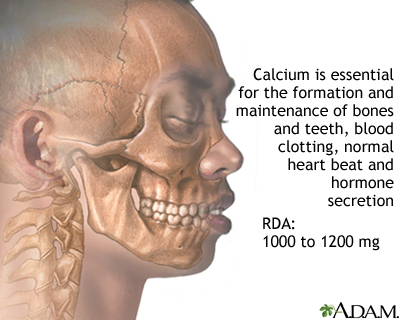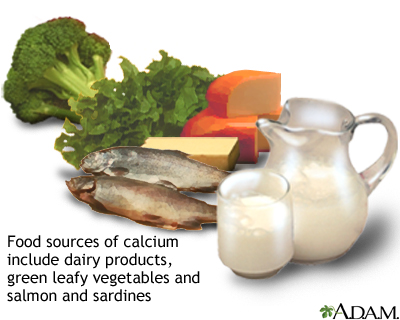Calcium in diet
Diet - calcium
Calcium is the most plentiful mineral found in the human body. The teeth and bones contain the most calcium. Nerve cells, body tissues, blood, and other body fluids contain the rest of the calcium.
Images


Function
Calcium is one of the most important minerals for the human body. It helps form and maintain healthy teeth and bones. A proper level of calcium in the body over a lifetime can help prevent osteoporosis.
Calcium helps your body with:
- Building strong bones and teeth
- Clotting blood
- Sending and receiving nerve signals
- Squeezing and relaxing muscles
- Releasing hormones and other chemicals
- Keeping a normal heartbeat
Food Sources
CALCIUM AND DAIRY PRODUCTS
Many foods contain calcium, but dairy products are the best source. Milk and dairy products such as yogurt, cheeses, and buttermilk contain a form of calcium that your body can easily absorb.
Whole milk (4% fat) is recommended for children ages 1 to 2. Most adults and children over age 2 should drink low-fat (2% or 1%) milk or skim milk and other dairy products. Removing the fat will not lower the amount of calcium in a dairy product.
- Yogurt, most cheeses, and buttermilk are excellent sources of calcium and come in low-fat or fat-free versions.
- Milk is also a good source of phosphorus and magnesium, which help the body absorb and use calcium.
- Vitamin D is needed to help your body use calcium. Milk is fortified with vitamin D for this reason.
OTHER SOURCES OF CALCIUM
Other sources of calcium that can help meet your body's calcium needs include:
- Green leafy vegetables such as broccoli, collards, kale, mustard greens, turnip greens, and bok choy or Chinese cabbage
- Salmon and sardines canned with their soft bones
- Almonds, Brazil nuts, sunflower seeds, tahini, and dried beans
- Blackstrap molasses
Calcium is often added to food products. These include foods such as orange juice, soy milk, tofu, ready-to-eat cereals, and breads. These are a very good source of calcium for people who do not eat a lot of dairy products.
Ways to make sure you get enough calcium in your diet:
- Cook foods in a small amount of water for the shortest possible time to keep more calcium in the foods you eat. (This means steaming or sautéing to cook instead of boiling foods.)
- Be careful about the other foods you eat with calcium-rich foods. Certain fibers, such as wheat bran, and foods with oxalic acid (spinach and rhubarb) can bind with calcium and prevent it from being absorbed. This is why leafy greens are not considered an adequate source of calcium by themselves, because your body is unable to utilize much of the calcium they contain. People on a vegan diet need to be sure to also include soy products and fortified products in order to get enough calcium.
DIETARY SUPPLEMENTS
Calcium is also found in many multivitamin-mineral supplements. The amount varies, depending on the supplement. Dietary supplements may contain only calcium, or calcium with other nutrients such as vitamin D. Check the label on the Supplement Facts panel of the package to determine the amount of calcium in the supplement. Calcium absorption is best when taken in amounts of no more than 500 mg at a time.
Two commonly available forms of calcium dietary supplements include calcium citrate and calcium carbonate.
- Calcium citrate is the more expensive form of the supplement. It is taken up well by the body on a full or empty stomach.
- Calcium carbonate is less expensive. It is absorbed better by the body if taken with food. Calcium carbonate is found in over-the-counter antacid products such as Rolaids or Tums. Each chew or pill usually provides 200 to 400 mg of calcium. Check the label for the exact amount.
Other types of calcium in supplements and foods include calcium lactate, calcium gluconate, and calcium phosphate.
Side Effects
Increased calcium for a limited period of time does not normally cause side effects. However, receiving higher amounts of calcium over a long period of time raises the risk for kidney stones in some people.
Those who do not receive enough calcium over a long period of time can develop osteoporosis (thinning of bone tissue and loss of bone density over time). Other disorders are also possible.
People with lactose intolerance have trouble digesting lactose, the sugar in milk. For this reason, they are often at risk for calcium deficiency. However, over-the-counter products are available that make it easier to digest lactose. You can also buy lactose-free milk at most grocery stores. Most people who do not suffer from severe lactose-intolerance are still able to digest hard cheeses and yogurt.
Tell your health care provider about any dietary supplements and medicines you take. Your provider can tell you if those dietary supplements might interact or interfere with your prescription or over-the-counter medicines. In addition, some medicines might interfere with how your body absorbs calcium.
Recommendations
The preferred source of calcium is calcium-rich foods such as dairy products. Some people will need to take a calcium supplement. How much calcium you need depends on your age and sex. Other factors, such as pregnancy and illnesses, are also important.
Recommendations for calcium, as well as other nutrients, are provided in the Dietary Reference Intakes (DRIs) developed by the Food and Nutrition Board at the National Academies of Sciences, Engineering, and Medicine. DRI is a term for a set of reference intakes that are used to plan and assess the nutrient intakes of healthy people. These values, which vary by age and sex, include:
- Recommended Dietary Allowance (RDA): The average daily level of intake that is enough to meet the nutrient needs of nearly all (97% to 98%) healthy people. An RDA is an intake level based on scientific research evidence.
- Adequate Intake (AI): This level is established when there is not enough scientific research evidence to develop an RDA. It is set at a level that is thought to ensure enough nutrition.
Dietary Reference Intakes for calcium:
Infants (AI):
- 0 to 6 months: 200 milligrams per day (mg/day)
- 7 to 12 months: 260 mg/day
Children and adolescents (RDA):
- Age 1 to 3: 700 mg/day
- Age 4 to 8: 1,000 mg/day
- Age 9 to 18: 1,300 mg/day
Adults (RDA):
- Age 19 to 50: 1,000 mg/day
- Age 51 to 70: Men - 1,000 mg/day; Women - 1,200 mg/day
- Over age 70: 1,200 mg/day
Pregnancy and breastfeeding (RDA):
- Age 14 to 18: 1,300 mg/day
- Age 19 to 50: 1,000 mg/day
Up to 2,500 to 3,000 mg a day of calcium from dietary sources and supplements appears to be safe for children and adolescents, and 2,000 to 2,500 mg a day appears to be safe for adults.
The following list can help you determine roughly how much calcium you are getting from food:
- 8-ounce (240 milliliter) glass of milk = 300 mg of calcium
- 8-ounce (240 milliliter) glass of calcium-fortified soy milk = 300 mg calcium
- 1.5 ounces (42 grams) of cheese = 300 mg of calcium
- 6 ounces (168 grams) of yogurt = 300 mg of calcium
- 3 ounces (84 grams) of sardines with bones = 300 mg of calcium
- ½ cup (82 grams) of cooked turnip greens = 100 mg of calcium
- ¼ cup (23 grams) of almonds = 100 mg of calcium
- 1 cup (70 grams) of shredded bok choy = 74 mg of calcium
Vitamin D is needed to help the body absorb calcium. When choosing a calcium supplement, look for one that also contains vitamin D.
Related Information
Muscle crampsEnzyme
References
Cosman F, de Beur SJ, LeBoff MS, et al. Clinician's guide to prevention and treatment of osteoporosis. Osteoporos Int. 2014;25(10):2359-2381. PMID: 25182228 pubmed.ncbi.nlm.nih.gov/25182228.
Institute of Medicine, Food and Nutrition Board. Dietary Reference Intakes for Calcium and Vitamin D. National Academies Press. Washington, DC. 2011. PMID: 21796828 pubmed.ncbi.nlm.nih.gov/21796828/.
Markell M, Siddiqi HA. Vitamins and trace elements. In: McPherson RA, Pincus MR, eds. Henry's Clinical Diagnosis and Management by Laboratory Methods. 24th ed. Philadelphia, PA: Elsevier; 2022:chap 27.
Mason JB, Booth SL. Vitamins, trace minerals, and other micronutrients. In: Goldman L, Schafer AI, eds. Goldman-Cecil Medicine. 26th ed. Philadelphia, PA: Elsevier; 2020:chap 205.
National Institutes of Health website. Calcium: fact sheet for health professionals. ods.od.nih.gov/factsheets/Calcium-HealthProfessional/. Updated October 6, 2022. Accessed February 8, 2023.
US Department of Agriculture, Agricultural Research Service. FoodData Central. fdc.nal.usda.gov/index.html. Updated 2019. Accessed February 8, 2023.
BACK TO TOPReview Date: 1/19/2023
Reviewed By: Stefania Manetti, RD/N, CDCES, RYT200, My Vita Sana LLC - Nourish and heal through food, San Jose, CA. Review provided by VeriMed Healthcare Network. Also reviewed by David C. Dugdale, MD, Medical Director, Brenda Conaway, Editorial Director, and the A.D.A.M. Editorial team.

Health Content Provider
06/01/2025
|
A.D.A.M., Inc. is accredited by URAC, for Health Content Provider (www.urac.org). URAC's accreditation program is an independent audit to verify that A.D.A.M. follows rigorous standards of quality and accountability. A.D.A.M. is among the first to achieve this important distinction for online health information and services. Learn more about A.D.A.M.'s editorial policy, editorial process and privacy policy. A.D.A.M. is also a founding member of Hi-Ethics. This site complied with the HONcode standard for trustworthy health information from 1995 to 2022, after which HON (Health On the Net, a not-for-profit organization that promoted transparent and reliable health information online) was discontinued. |
The information provided herein should not be used during any medical emergency or for the diagnosis or treatment of any medical condition. A licensed medical professional should be consulted for diagnosis and treatment of any and all medical conditions. Links to other sites are provided for information only -- they do not constitute endorsements of those other sites. © 1997- 2024 A.D.A.M., a business unit of Ebix, Inc. Any duplication or distribution of the information contained herein is strictly prohibited.
